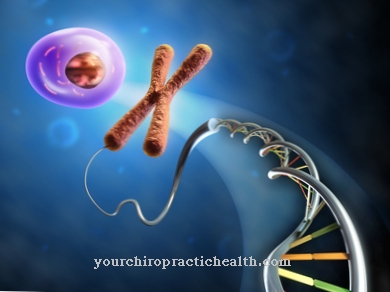In the Mineralization minerals are stored in hard tissue, such as teeth or bones, to harden. There is a permanent balance between mineralization and demineralization in the body. If there is a mineral deficiency or other mineralization disorders, this balance is disturbed.
What is the mineralization?

In hard tissues such as teeth or bones, inorganic substances are permanently deposited in the organic matrix. These substances are mainly salts such as hydroxyapatite, phosphate or fluoride. Calcium is one of the most important substances in bone formation.
The process of storage is controlled by the organic matrix. The collage plays a key role in the control processes. The processes described are called mineralization or Mineralization designated. In relation to the bones, mineralization is a major part of ossification and fracture healing.
The opposite process is known as demineralization. Salts are released from the hard tissue. What remains is the collagen matrix. Demineralization and mineralization are physiologically in harmony in the hard tissues of the human organism.
Another term from this area is remineralization, i.e. the storage of inorganic substances after demineralization. Mineralization takes place primarily in the formation of new hard tissues.
Function & task
Living bone is permanently aligned with the current functional needs by the bone-building osteoblasts and the bone-removing osteoclasts. Bone formation (osteogenesis) competes with bone loss (osteolysis) for a lifetime. Mineralization permanently competes with demineralization.
Osteoblasts give off a basic organic substance called the bone matrix. This basic substance is then mineralized through the mediation of the osteoblasts. The mineralization processes depend on the amount of phosphate and calcium in the plasma.
The control of the osteoblasts and thus the mineralization is subject to the influence of hormones such as parathyroid hormone, calcitonin and calcitriol. Estrogens, somatotropins and glucocorticoids also take on control functions in bone cell activity and thus in all mineralization and demineralization processes.
Thanks to the balanced alternation between mineralization and demineralization, the skeleton can always be adapted to new loads and needs without breaking. Because of these continuous processes, humans receive a new skeleton about every seven years.
The hormones involved provide the required minerals and vitamins for mineralization in large quantities. In this way, they mobilize the working materials of the osteoblasts, so to speak, and also have a stimulating effect on the cells of the bone structure. In order to mineralize the bones and absorb calcium from the intestine, vitamin D is essential, which is obtained primarily through exposure to the sun.
Constant build-up and breakdown processes also take place on the teeth. The saliva is of great importance for these processes. Tooth enamel consists of around 98 percent stored minerals. They give the teeth their extreme hardness and thus give people their biting power. Tooth enamel mainly contains calcium, phosphorus and magnesium or fluoride.
Tooth enamel is exposed to constant demineralization due to dietary acids. The saliva protects the teeth from loss of tooth enamel and remineralises minor tooth enamel damage with its minerals. On the other hand, the saliva also contains microorganisms for breaking down excess tooth enamel. It thus occupies a key position in the cycle of mineralization and demineralization.
Illnesses & ailments
Pathological mineralization is present in concrements, for example. These are solids in the cavities of the body, which consist of dissolved hard substance parts. In this context, hard plaque under the marginal gingiva is referred to as tartar. The calculus is created by minerals from the saliva that accumulate in plaque. Genetic factors are associated with the tendency towards tartar formation. A lack of mineralization on the teeth and bones can be due to a lack of minerals.
Mineralization disorders are widespread and are usually associated with abnormal calcium phosphate levels. The concentrations of the two substances depend on one another due to the constant solubility product. A large part of the calcium and phosphate supply is deposited as hydroxyapatite in the bone. If there is an imbalance in the body of one of the two minerals or if the absorption of the substances in the gastrointestinal tract is imbalanced with the excretion of substances by the kidneys, the fluctuations in concentration are countered either by storage or depletion. Both can take on pathological proportions.
Such a phenomenon occurs in the context of rickets. In adults, this disease is known as osteomalacia. The most common form of rickets is calcium deficiency rickets, which is preceded by vitamin D deficiency.
The dentition can also be affected by mineralization disorders. Examples of this are the amelogenesis imperfecta and the dentinogenesis imperfecta. Amelogenesis imperfecta is a genetic disease that disrupts the formation of tooth enamel and external tooth structure. Dentinogenesis imperfecta is also a genetic disease. Instead of the formation of the enamel, the formation of the inner tooth substance and thus the dentine is disturbed in this disease.
Mineralization problems can affect the deciduous teeth. If only individual teeth are affected, it is called a localized disorder. If all teeth are affected, the dentist speaks of a generalized mineralization disorder. Teeth with impaired mineralization are yellowish to brown in color and often have flaking off the tooth enamel. Changes in shape, increased temperature sensitivity and the tendency to caries are also often part of the clinical picture. The cause is a lack of minerals in the tooth enamel. The reasons for this deficiency have not been conclusively researched.













.jpg)

.jpg)
.jpg)











.jpg)